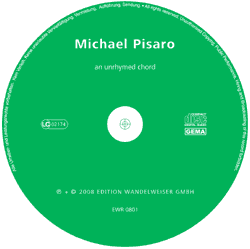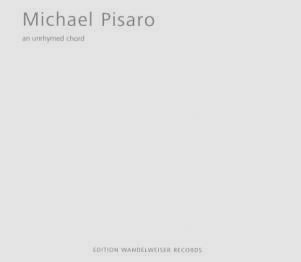EDITION WANDELWEISER RECORDS
> CD catalogue
> Michael Pisaro
_____________________________________________________________________
<< >>
Michael Pisaro
an unrhymed chord
| order reference:
medium: composer: performer: |
EWR 0801/02 CD Michael Pisaro 0801 Greg Stuart (percussion) 0802 Joseph Kudirka (realisation) |
 |
 |
 |
greg stuart: an unrhymed chord is a deceptively simple piece. from the score we see that each performer picks a single sound, sustains this sound for one to fifteen minutes in each half of the piece, and that amplitude is inversely proportional to duration. it does not seem like much in the way of instructions for a piece that lasts just over an hour. however, after I started making a realization I quickly realized how dynamic the situation the piece presents actually is. I had never heard a music quite like it: a continuously shifting harmonic mass where a sound could be clearly present, disappear, and reappear at a later point sounding markedly different. at other times the addition or subtraction of a sound would make a sound that had been present not disappear but bend slightly. all of this is accomplished by the inverse relationship between amplitude and duration, and like an elegant mathematical proof, it simply has to be this way in order to function. for this version I used a wide array of percussion instruments, household items and found objects (metal, stone, clay, ceramic and skin). all of the sounds, of which there are seventy, were made by friction—either by bow, stick or hand. joseph kudirka: this version of an unrhymed chord was assembled from sounds supplied as audio files, sent to me by a group of musicians known to michael and myself. the only condition I placed on the contributions was that sounds were to be electronically generated in a non-performative fashion, the goal being to make this not a recording in the traditional sense, but rather a digital realization, designed to be equal in all listening environments, as none of the parts were created in a way dependent on a particular physical space or time. apart from the final mixing done by michael and I, no performers had knowledge of what the others had done. my work consisted of placing sound files in time (usually at times in accordance with very specific clock-timing instructions given by contributors), and setting their volume levels respective to one another. the volume of each part was determined by a mathematical formula suggested by the score, though some levels were changed based on perceived volume by ear. sound contributions by by: peter ablinger, martin arnold, antoine beuger, brad breeck, madison brookshire, ezra buchla, raven chacon, douglas cohen, andre cormier, nick didkovsky, jeremy drake, thadeus frazier-reed, august friscia, james fulkerson, kraig grady, arthur jarvinen, travis just, lewis keller, david kendall, joseph kudirka, matthew marble, jonathan marmor, john maus, james orsher, adam overton, michael pisaro, larry polansky, mark so, phillip stearns, burkhard schlothauer, craig shepard, chiyoko szlavnics, lee weisert, michael winter, amnon wolman > top |